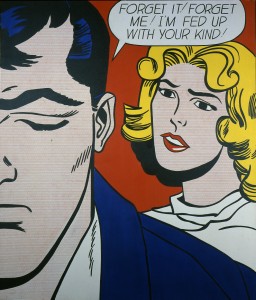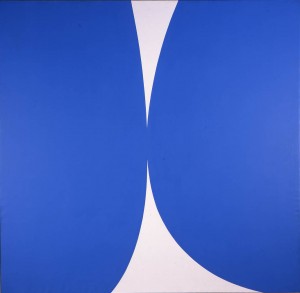
Roy Lichtenstein, Forget It! Forget Me! 1962. Gevirtz-Mnuchin Purchase Fund, 1962. Copyright Estate of Roy Lichtenstein.
With all of the buzz about the contemporary in Boston, it might be easy to neglect the incredible collection the Rose Art Museum has maintained of 20th Century art. Located at Brandeis, the museum has long been at the forefront of supporting and collecting American art, and the names displayed on its walls—de Kooning to Rosenquist; Lichtenstein and Warhol—are a who’s who of the greatest hit makers of the past century.
On display through May 20, 2012, Art at the Origin: The Early 1960s shows works created by these masters of American art from 1961-1965. What’s more: the majority of these works were also acquired during this period—the first five years of the Rose Art Museum’s existence. This only serves to highlight the quantum leap in front of its Boston brethren that the Rose took during the 60s, as the MFA and others are just starting to catch up. With all the emphasis at amassing contemporary works some 50 years later, it is amazing to see how much daring went into starting this collection.
Half the works in the show were acquired in 1962-1963 through the Gevirtz-Mnuchin Purchase Fund, which supported the acquisition of experimental American art and enabled the formation of the first avant-garde collection at a university museum. Key pieces by Roy Lichtenstein, Ellsworth Kelly, Claes Oldenburg, Willem de Kooning, Robert Rauschenberg, Andy Warhol, and Marisol are displayed in the newly renovated Gerald S. and Sandra Fineberg Gallery.
Accompanying the exhibition is an excerpt of a personal memoir by Sam Hunter, the founder of the Rose Art Museum at Brandeis. The exhibition itself, and the recollections of its founder, are timed perfectly, given the controversy surrounding the Rose in recent years and the contemporary climate for art in Boston. The questions concerning the possible closure of the museum, and the ravenous appetite Boston has acquired for 20th Century art are both answered with a trip to this show. Even with the monuments to art that are being built, expanded, and marketed with generous funds and stellar attendance this season, the Rose’s collection remains one of the best sources for seeing the explosion of American art firsthand, and Art at the Origin is the Rose at its very best.

